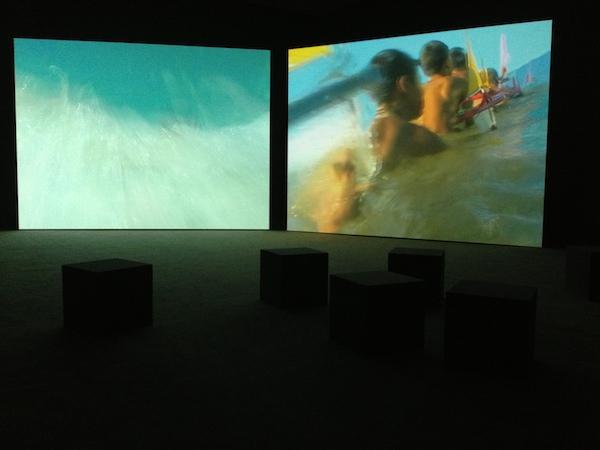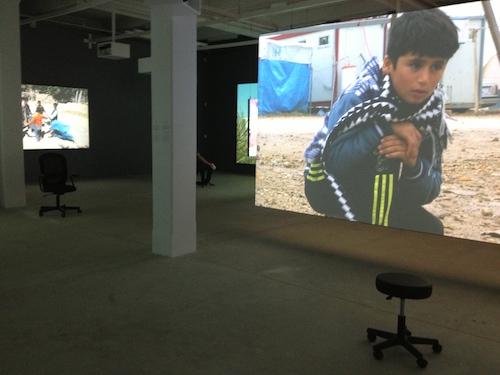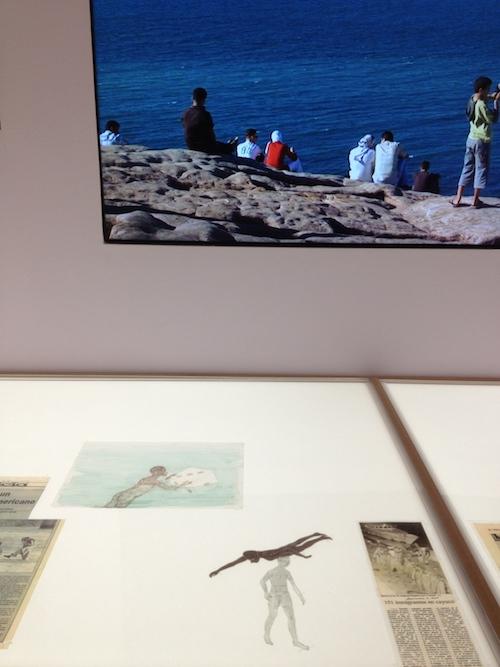藝評
Playing along—a letter to Francis Alÿs
楊陽 (Yang YEUNG)
at 10:24am on 21st December 2020





Caption:
1.-5. Installation views of the exhibition ‘Wet feet __ dry feet: borders and games, solo exhibition of Francis Alÿs’, Tai Kwun Contemporary. All photos: Yang Yeung
(原文以英文發表,題為〈一起去玩 — 一封給Francis Alÿs的信〉。)
Dear Francis,
You lend a slender touch. You lay down no wilful centre. I end up being drawn to a detail—the frown of the boy in pink. I am sure you know who I am referring to—the ten-year-old flying a kite. [1] Perhaps it is the glare of the midday sun. Perhaps it is the intense concentration.
This is the only video of Children’s Games on your website that is accompanied by a written interpretation. Your words flow as the boy’s arms do, finding pleasure in failing to catch up: a body “in action with unknown forces, pulling to the left, pulling to the right, up, down, quick, over to the left again, and so on and on.” An exclamation underlies the current of words you activate. You name what you see: “the mastery of non-mastery”. For me, I would add that you show an accidental beauty of non-mastery becoming mastery, a cursive script of and in the air, always in-the-making. Such agility: he stretches his arms as far to the sides as he can so the kite becomes light enough for the wind. He joins them back swiftly so the paper diamond returns to a momentum ready for the next launch. Is this “domination of nature all in one”? I see him rather as a medium of the inanimate and the changing rhythms of nature—I see the commensurate and the coextensive. His confidence and strength are not self-conscious, which brings out more beauty from his moves. His mission seems more than to free the kite into the air: also to lift his body off the ground and his Being up into the sky. I wonder how long he keeps moving this way, his way.
Sunlight is a dance in Espejos [2]. It casts shadows, and drapes a fluid castle upon the built one. The boys, by the names of Isaac, Diego, Benjamin, Isaac, and Sergio, run in and out of both castles, pursuing light, pursuing each other. In subtle twists of the palm, they turn the fragment of a mirror into, at once, a light gatherer and a light dispenser. Move to aim, miss, and run, aim again, all the while voicing the imaginary sound of a trigger at work—tightening, releasing. Did you, Francis, play along? Did you ask to? If you had, would the shadows of the walls have been enough of a shelter? Would you prioritise light, speed, or shadow in your moves? Perception is everywhere; the children move and are moved by it. Is this not the “intimate coupling between movement and perception” that the anthropologist Tim Ingold observes in grown-ups skilled in the handling of tools? [3] Only that in Espejos, broken mirrors are not tools that serve a pre-designed function in a closed system, yet their rhythmic responses to what is around them are similar: “In this responsiveness there lies a form of awareness that does not so much retreat as grow in intensity with the fluency of action.” [4] Lines are drawn and re-drawn, some mobius-strip-like, varying and persisting. Memory must have begun in children in the body, from the body.
That same year, you follow grasshoppers. [5] Do we call the way children mutilate their hind legs violence, or is it more innocence—this repetitive casting of their playmates into a perpetual flight and fall without the hopping-in-between? Such grown-up words—violence, innocence. I picture you running around with them in the field. How did you choose whom to follow? How far did you go? Do you know how they first discovered such practical aeronautical knowledge? What comes before the game? How do they lead newcomers into the game? How charged is each of their throw—the whole body elongates, gathering around them the open sky and the expanse of air, to release the green critters once more. They must also have been tender, too—catching their playmates’ half-broken body for the next throw. No competition. No ownership. No boundary. Only cheering, laughing, sharing.
The magnanimity of their free bodies reaching out to infinity makes me think of the “Open” in Rilke. “The Eighth Elegy” speaks of a “pure space” that is not the “world” grown-ups see:
“Only our eyes are turned backward, and surround plant, animal, child/ like traps, as they emerge into their freedom.” We have death before us, but not “that pure space into which flowers endlessly open”. And the animal? “[The] free animal / has it decline in back of it, forever, / and God in front, and when it moves, it moves / already in eternity, like a fountain.” So majestically slow, so present but not full of itself. For the child: “Nowhere without the No: that pure / unseparated element which one breathes / without desire and endlessly knows. A child / may wander there for hours, through the timeless / stillness, may get lost in it and be shaken back.” [6]
I came across this poem reading Jalal Toufic’s essay “On Names”. [7] You know how he leaves a curious footnote, [8] as if for Rilke: “Is anyone who has the potential to undergo an over-turn ever in the Rilkean Open? Is it legitimate to advance that one day the human child in the mirror turned toward himself, and was no longer in the Rilkean Open?” This Rilkean Open, that Toufic describes as that which comes before a name [9], is more difficult reach for humans than for flowers because, “[r]eaching the condition prior to any name requires that one get to a time that precedes one’s interpellation of oneself (in the mirror) or that instances its undoing.” Perhaps an infant up to a year old, or the “transitory madness of King Lear”, says Toufic. At first I thought Toufic sounded harsh—that over-turn that the dead undergoes, which “undoes his or her turn to answer the call by his or her proper name,” [10] is something that a mortal would never experience, including children. But then I thought he might be following along with Rilke to lend caution to how grown-ups take away the Rilkean Open in children. It may also have to do with what one does after the interpellation—children may move on or return to their own worlds, while we may be exaggerate the pressure to show up as names require. Francis, did you encounter the children in the Open? Have they led you into their Open?
Which brings me to the girls in Kathmandu playing knucklebones: [11] each round, a cadence. As they spread open their palms on the ground and sweep the stones into a dance, a cradle for intimacy and intricacy is born. Their hands are eloquent as water is, making it at once a marvel and a challenge for the spectator to follow. They exchange chances and admiration. Seeing their reciprocal movements, I start reflecting on how the words “game” and “play” direct our attention differently. In an interview, [12] you said you are interested in archetypal games. I see in your videos, however, it is not just “games” but the activity of playing that is manifested. “Game” may be the name for the structure; it is however the playing, the embodiment, that teaches us about freedom. Some years ago, an artist based in San Francisco introduced me to Hans-Georg Gadamer. On “play”, he says it is like “reading” when the activity does not generate a “new independent reality, we nevertheless always seem to be moving in that direction.” [13] It is “borderline” the way reading is. “Play is less the opposite of seriousness than the vital ground of spirit as nature, a form of restraint and freedom at one and the same time. […] For these our forms of play are forms of our freedom.” [14] I find your depiction of the children playing anti-compositional. You focus on how they bring their moments to life, how they play them out. You preserve the ways they play rather than tell stories about them.
What does it take for them to be where you found them? Are their games routine, or moments of luxury out of other chores? Are we seeing nothing special, or are we touching a fragility or precariousness for which we cannot or are too arrogant or ignorant to name the causes? What is left unshown? I cannot help but think of children’s bodies that are constrained by deliberate policies of all kinds. If you make it to Hong Kong, you will probably encounter the common sight of children burdened with schoolbags the size of their torsos, walking in single file into schools. Children have also been burdened with injury and death. During the pro-democracy movement last year, children were among the protestors on the streets, children with their parents. Others tried to deliberate with the police. Anthropologist Sealing Cheng’s nine-year-old daughter wrote “in her best-ever handwriting” a letter to “Mr Policeman”, and with “two full pages featuring twenty photographs as evidence of police brutality.” She writes, “Let us talk about violence.” Her six-year-old daughter drew a tearful Pikachu with a thought bubble picturing his own death. Cheng says, “If we recognise that children are important stakeholders in the future—and the current movement in Hong Kong is essentially about its future—then it is crucial to see the strength in Pikachu’s tears.” [15] The conflict zones we have been in keep changing shape; the others you have seen—how have they been?
I wish I could see the moment the children welcome you, at your first encounter, and the subsequent ones. There is something special about a child’s welcome—an energy, strength, and mischief, too, that could (re)turn a brilliant sparkle in every dull grown-up’s life. Allow me to end by sharing with you this little episode from the recent past. In 2005, one year after the tsunami hit the long coastlines of South and Southeast Asia, I visited a fishermen’s village in Machilipatnam in the state of Andhra Pradesh, India. I joined the villagers in an informal village assembly. Little was exchanged in language, but much warmth resided in the smiles and eye contact. We were about to get up to visit some fishermen at the shore, when all of a sudden, I felt a small hand slipping into my right palm. It was a little girl. Her black curly hair was shiny and thick. Her left eye was a little cloudy. She wouldn’t stop looking me in the eye. She became the one who led me through the bush to the infinite and majestic beach stretching out from where the vegetation ended. The sea was grey, the waves, tall. She let go of my hand and started running around, playing with her mates, dashing her small feet upon the backwash. I am still in awe as to how the healing of her relation with the sea had come so soon, so tenderly, how she cannot but still love the sea, perhaps even more strongly.
Children don’t wait. Why do we, moving forward with our backs turned towards the future, until it’s too late?
Yang
writing from Hong Kong
Endnotes:
[1] Children’s Game #10 Papalote, Balkh, Afghanistan 2011
[2] Children’s Game #15, Espejos, Ciudad Juarez, 2013
[3] Tim Ingold, Being Alive: Essays on Movement, Knowledge and Description. Oxon: Routledge. 2011:59
[4] ibid., p.61
[5] Children’s Game #9, Saltamontes, Salto Acha, Venezuela 2011
[6] The Selected Poetry of Rainer Maria Rilke, ed. and trans. Stephen Mitchell. New York: Vintage. 1989:193.
[7] Jalal Toufic, Forthcoming. 2nd Edition. Berlin: Sternberg Press. 2014:180 (Available online: http://www.jalaltoufic.com/downloads/Jalal_Toufic,_Forthcoming,_2nd_edition.pdf. Accessed Sept 21, 2020)
[8] ibid., p.276, footnote 184
[9] ibid., p.183
[10] ibid.
[11] Children’s Game #18 Knucklebones, Kathmandu, 2017
[12] See https://www.youtube.com/watch?v=XlbMXLQWvfg. Accessed Sept 21, 2020
[13] Hans-Georg Gadamer. The Relevance of the Beautiful and Other Essays, ed. and trans. Nicholas Walker. Cambridge: Cambridge University Press. 1986:126-7.
[14] ibid., p.130
[15] Sealing Cheng, “Pikachu’s Tears: Children’s Perspectives on Violence in Hong Kong” in Feminist Studies, Vol. 46 No. 1 (2020), pp. 216-225.
This article was first published by Tai Kwun Contemporary, Exhibition Guidebook for Wet feet __ dry feet: borders and games, solo exhibition of Francis Alÿs, 2020.
